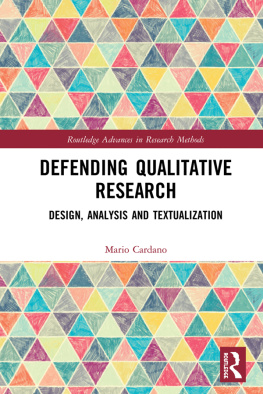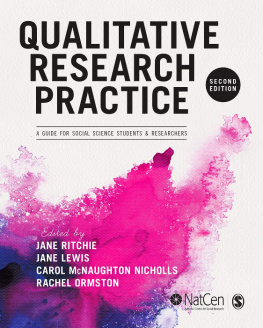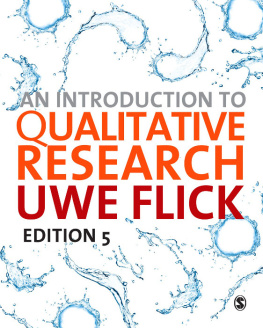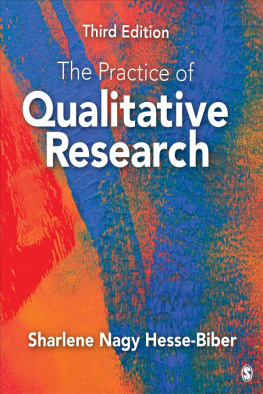The How To of Qualitative Research
The How To of Qualitative Research
- Janice D. Aurini
- Melanie Heath
- Stephanie Howells
SAGE Publications Ltd
1 Olivers Yard
55 City Road
London EC1Y 1SP
SAGE Publications Inc.
2455 Teller Road
Thousand Oaks, California 91320
SAGE Publications India Pvt Ltd
B 1/I 1 Mohan Cooperative Industrial Area
Mathura Road
New Delhi 110 044
SAGE Publications Asia-Pacific Pte Ltd
3 Church Street
#10-04 Samsung Hub
Singapore 049483
Janice D. Aurini, Melanie Heath and Stephanie Howells, 2016
Apart from any fair dealing for the purposes of research or private study, or criticism or review, as permitted under the Copyright, Designs and Patents Act, 1988, this publication may be reproduced, stored or transmitted in any form, or by any means, only with the prior permission in writing of the publishers, or in the case of reprographic reproduction, in accordance with the terms of licences issued by the Copyright Licensing Agency. Enquiries concerning reproduction outside those terms should be sent to the publishers.
First published 2016
Library of Congress Control Number: 2015956035
British Library Cataloguing in Publication data
A catalogue record for this book is available from the British Library
ISBN 978-1-4462-6708-0
ISBN 978-1-4462-6709-7 (pbk)
Editor: Mila Steele
Production editor: Sushant Nailwal
Copyeditor: Andy Baxter
Proofreader: Derek Markham
Indexer: Avril Ehrlich
Marketing manager: Ben Griffin-Sherwood
Cover design: Wendy Scott
Typeset by: C&M Digitals (P) Ltd, Chennai, India
Printed and bound by CPI Group (UK) Ltd, Croydon, CR0 4YY
This book is dedicated to the hundreds of people who have graciously participated in our research projects over the years.
Summary of Contents
List of Figures
List of Tables
About the Authors
Janice D. Auriniis an Associate Professor in the Department of Sociology and Legal Studies at the University of Waterloo. She completed her Ph.D. at McMaster University and was a postdoctoral fellow at Harvard University. Her research examines education policy, education inequality, private education and parenting. Dr. Aurini has conducted field work, interviews and photo-interviews. She has also worked on several mixed methods projects. Her recent articles can be found in
Sociology of Education,
Canadian Public Policy and
Canadian Journal of Sociology. She is currently the primary investigator on a five-year SSHRC funded project on summer learning inequality.Melanie Heathis an Associate Professor in the Department of Sociology at McMaster University. She completed her Ph.D. at University of Southern California and was a postdoctoral fellow at Rice University. Her research examines marriage promotion policies in the United States, and she is author of
One Marriage Under God: The Campaign to Promote Marriage in America (New York University Press, 2012). She has conducted field work, interviews, focus groups, and textual analysis. Her research has been published in
Gender & Society,
Qualitative Sociology,
Sociological Quarterly, and
Contexts. She is currently the primary investigator on a five-year SSHRC funded comparative project on government regulation of polygamy in Canada, France, and the United States.Stephanie Howellsis an Assistant Professor in the Department of Sociology and Anthropology at the University of Guelph. She completed her Ph.D. in the Department of Sociology at McMaster University. Her doctoral research focused on the cultural and organizational processes that lead to inflated perceptions of school violence, and seemingly disproportionate policy responses. Her research is generally centered on education, crime, violence and youth. She has worked on several mixed methods research projects, and has conducted focus groups, personal interviews, and media analyses in her qualitative research.
Companion website
The How To of Qualitative Research is supported by online resources for lecturers to aid study and support teaching. These are available at https://study.sagepub.com/auriniheathandhowells and include:
PowerPoint slides for each chapter, which can be quickly adapted for use in classroom or virtual learning teaching and presentations.
Testbanks for each chapter, which include both multiple choice and short answer questions that can be used in exams or assigned as homework.
Part I Jump Starting Your Qualitative Research Project
Introduction: From Why to How in Qualitative Research
I want to understand the world from your point of view. I want to know what you know in the way you know it. I want to understand the meaning of your experience, to walk in your shoes, to feel things as you feel them, to explain things as you explain them. Will you become my teacher and help me understand? (Spradley, 1979: 34)
Spradley originally made this classic statement about ethnographers; yet for many it captures the broader essence of what it means to be a qualitative researcher. As qualitative researchers we are interested in describing the context and meaning of individual and group life and understanding how people make sense of the world around them. Our methodological toolkit allows us to examine how broader structural, historical and cultural conditions influence peoples perspectives, experiences and choices. Interviews, field observations, and physical and social traces tell a unique story about the complexity of human development and group life.
Based on these qualities, it is no surprise that qualitative research has arrived. As studies continue to multiply, so too have the number of books about qualitative research methods. If you are new to qualitative methods, you will find no shortage of excellent books that broadly describe types of qualitative research, questions that different methods address, approaches to qualitative research, and ethical issues (e.g., Creswell, 2013; Hesse-Biber et al., 2010; Silverman, 2009). Other sources focus on a specific approach such as grounded theory (e.g., Corbin and Strauss, 2008). Complementing these books, you can also find edited volumes that provide useful overviews of the field, including discussions of competing paradigms and broad explanations of interpretive traditions (e.g., Denzin and Lincoln, 2011).















